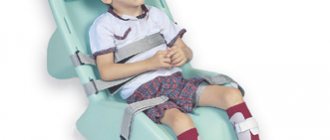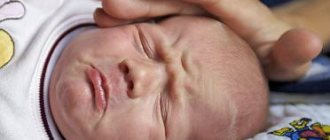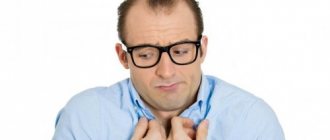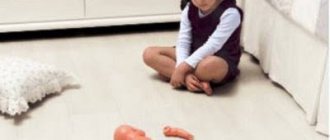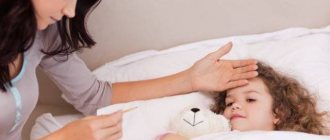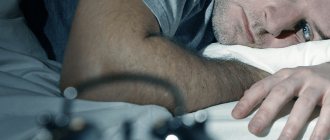CHILDHOOD AUTISM
Some “luminaries” of psychiatry claim that autism in children cannot be treated. But the experience of parents says the opposite. In many children, against the background of modern treatment methods and remedial classes, the manifestations of autism are gradually smoothed out. In a child diagnosed with autism, excitability and stereotypic activity decrease, speech and social skills begin to develop. And if it is impossible to “cure autism,” then improving behavior, developing speech and socially adapting the child is not only possible, but also NECESSARY. Signs of autism in children that lead to the diagnosis (syndrome) of autism:
1. Detachment. A child with autism seems to be in his own world, is not able to make contact, cannot and does not try to ask for what he needs, is attached to his mother in everyday life or emotionally (for example, he cannot eat and dress himself or communicates only with the mother, but avoids strangers), however, the autistic child may avoid physical contact (for example, does not allow himself to be hugged). Autism in a child is often manifested by impaired eye contact (children do not make eye contact and even deliberately look away or turn away if you try to catch his gaze).
2. Speech disorder. Speech disorder. Children with autism either do not speak at all, but only shout out inarticulate sounds (vocalisms). Or they only speak individual words, repeating them as if in an echo behind their parents or TV (this is called echolalia), without understanding the meaning; other autistic children have template phrases (the child pronounces this phrase correctly and it can be close to the situation, for example: “give me salad” - asks for food, but not a salad at all, “end of the movie” - tired of your presence and wants you to leave and many more similar phrases). Some children with autism can pronounce entire sentences in a pattern and even retell entire fairy tales, but do not answer questions or engage in dialogue. All of the above is usually called a disorder of speech and its communicative function. In mild cases, a child with autism speaks, but does not use personal pronouns (for example, an autistic child says to himself: “the boy wants to eat”).
3. Violation of mental and speech development. Disorders of mental and speech development. Almost all children with autistic manifestations have impaired mental and speech development. The degree of developmental delay is very individual and depends on the form of autism (for example, with Kanner syndrome in children there is a very severe developmental delay, and with Asperger syndrome, on the contrary, intellectual development can be almost normal). In early childhood autism (ECA), the baby first developed correctly, and then the skills “disintegrated” under the influence of various negative factors (according to the observations of parents, the cause of the disintegration in their autistic children was: DTP vaccination, large-area burns, anesthesia during a serious operation, extremely painful procedures carried out in a hospital, serious stress or fear - for example, burglars broke into the house and other “extreme” situations). That is, with RDA: before the child spoke, ate himself, played ordinary children's games.... and then I forgot how to do it and stereotypical activities appeared.
4. Violation of social adaptation. A child with autism does not interact with other children and sometimes even avoids them. Violation of social adaptation becomes especially noticeable in kindergarten. When the child was sent to kindergarten, it suddenly turned out that he had autistic manifestations (the child refuses to eat in kindergarten, sits away from the children for hours, does not play with toys with him, does not fulfill the requirements and requests of the teacher, or rather, does not respond to them at all does not react). Some children with autism may also have aggression towards children.
5. Stereotypical activity. Many actions of an autistic child become stereotypical—that is, they are repeated aimlessly. So-called “stereotypes” look different. Some children with autism shake their hands, others run in circles - “manage running”, line up objects in order, pour sand for hours, tear paper into thin strips. There are a great many variants of stereotypies in autistic children, but they are united by fixation and aimless repetition. In the distant 70s, psychiatrists believed that autism in children was a schizophrenia spectrum disorder, so even EDA (early childhood autism) was called early childhood schizophrenia. However, in recent decades, even psychiatrists have recognized that autism in children is not schizophrenia.
You asked:
Patient safety is controlled not by a patent, but by the Ministry of Health, which issues a license to a medical institution to carry out medical activities. As well as certifying bodies that allow or do not allow medical equipment for use.
The BIORS device for conducting transcutaneous microcurrent reflexology is registered by Roszdravnadzor as a medical device and has successfully passed all clinical trials and technical testing. The documents can be found here. Upon request, administrators will show the necessary original documents.
Now regarding the differences between the two devices.
Let's start with the fact that reflexology itself as a method of treatment through influencing biologically active points is a heritage of ancient Chinese medicine. Eastern healers treated ailments using needles, candles, coins, leeches, etc.
Modern medicine has confirmed the effectiveness of treatment through action on biologically active points and improved the technique. Painful acupuncture and cauterization have been replaced by hardware techniques: magnetic therapy, EHF and microcurrents. In this sense, there is no need to talk about the uniqueness of the invention of Samara doctors. Biologically active points can be treated not only at Reatsentr. There are also no restrictions on microcurrent treatment. But Reatsentr Samara has the right to set restrictions on the use of its medical equipment.
Which device you prefer is up to you to decide. It is important that the procedure is carried out by experienced reflexologists who are able to correctly determine the area of influence and choose the desired mode of operation.
We invite you to read the reviews of our patients who have already undergone treatment. You can also come to our center to chat live with parents and ask their opinion. There are always enough people in the waiting area. Such a visit will not oblige you to anything at all. Finally, we provide links to independent reviews on social networks about treatment at the Indigo Children Research Institute.
And to top it off, let’s add: all the talk about the superiority of one device over another was provoked by Reatsentr, which was deliberately losing its income. The topic of discussion itself leads far away from the truly significant moments for a parent. It is important to cure the child, and not look at the device manufacturer’s label to perform a fundamentally identical procedure.
At the Research Institute, Indigo Children look at this whole controversy differently. There is not and cannot be a single universal treatment method. What helps one child may not be useful for another. That is why in 2014 The paths diverged between the team of the Samara Recreation Center and the team of Chelyabinsk specialists who later founded the Indigo Children.
At the Indigo Children Research Institute, we are convinced that only an integrated systematic approach gives truly pronounced results in rehabilitation. This means we need to provide a sufficient arsenal of techniques in one place, which means we need to invest in training specialists. The Indigo Children Research Institute chose this strategy for itself, and today you can find here, perhaps, everything that modern neurology has at its disposal throughout the world. And this is not only percutaneous reflexology. There are techniques that are difficult to find not only in the branches of the Reatsentr, but even in large clinics in the capital. The wealth of choice when prescribing a treatment regimen determines the success of the Indigo Children Research Institute.
Is it autism? Misdiagnosis of autism.
There is also an opinion that many children diagnosed with autism incorrectly - this is called overdiagnosis.
So if a child has brain damage caused by intrauterine infection (for example, cytomegalovirus infection), prematurity, birth asphyxia, birth trauma, intracranial hypertension, etc. then his external manifestations will be similar to autism. With the use of modern comprehensive rehabilitation methods, autistic manifestations begin to gradually smooth out and not a trace of “autism” remains. And then there is a long period of work to restore the child’s psycho-speech development.
Children with autistic manifestations (against the background of organic brain damage) can be brought to NORMAL.
Comment from Doctor of Medical Sciences, Leading pediatric neurologist of the central Samara department of REACENTR, Tatyana Alekseevna Gavrilova:
The development of the brain of an autistic child has its own characteristics:
1. The frontal lobes of the brain are responsible for consciousness, intelligence, logical thinking and initiative. In children with autistic manifestations (autism), as a rule, the activity of the frontal lobes is sharply reduced. Therefore, in children with autism, cognitive activity is severely reduced, detachment is expressed, and there is no interest in the environment. Impaired logical thinking in children with autism syndrome leads to a lack of understanding of current events; it is for this reason that autistic children are afraid of everything new and unusual (changes, new surroundings, new toys, new food, new people), since they do not understand: what it is, where did it come from and why is it needed.
2. Normally, the frontal lobes control and direct all other areas of the brain (speech, motor, sensory (hearing, vision), speech, etc.).
- For example: a small child climbed into a closet and scattered books on the floor (the frontal lobes, out of curiosity, gave the command to the motor zones to crawl to the closet and pull the books out of the closet, the visual zones to see what was inside on the pages - after cognitive interest was satisfied, books and closet became uninteresting to the child and he went to other objects in the room).
However, in autistic children, the frontal lobes “sleep” and do not direct other areas of the brain to study the surrounding reality. That is why the activities of an autistic child are stereotypical. Stereotypes - repeatedly repeated, unconscious, aimless actions (shaking hands, pouring sand, mechanically turning pages, etc.)
3. In order to talk, you need a close relationship between the frontal lobes and the speech areas of the brain. After all, everything we say is said consciously. In ordinary children, a desire first arises (I want “candy” or I want to “go for a walk”) - it is the frontal lobes that come up with the “task”, and the speech areas of the brain implement it - the child makes a request or demands.
In an autistic child, the frontal lobes “sleep” and do not give the speech zones “tasks.” As a result, a child with autism does not understand spoken language; does not realize that they are addressing him; does not try to make requests, an autistic child simply does not understand that you can ask and get what you want. Speech is absent or becomes stereotypical, for example, a child with autistic manifestations repeats words or even entire sentences aimlessly, without understanding the meaning of the spoken words (like memorized foreign words).
4. Many autistic children experience auto-aggression - the autistic child directs aggression towards himself (hitting himself or biting himself). There are two reasons for this: the child is angry that the surrounding reality does not meet his needs (for example: he wanted to roll the car in the usual stereotypical way, and his mother makes him repeat the words after her, the child begins to bite his hand or hits himself in the face, not understanding that the protest can be expressed in words). This is auto-aggression. But it also happens that auto-aggression is just a “mask”; in fact, the child has a headache. He is unable to endure, does not understand that he can complain to his parents, and hits himself on the head (headaches, as a rule, are observed in children with damage to the nervous system due to hydrocephalus). At the same time, the veins on the temples are clearly visible in children, they are capricious, and have a pained expression on their faces.
5. Autistic children, as a rule, have high activity in the visual areas of the brain. That is why they have a very good visual memory (it is also called “photographic”) and express a love of “contemplation.” The games of a child with autism are aimed at contemplation: autistic children examine the fingers of their hands, or throw objects and watch them “fall beautifully”; they can spend hours watching the same moment in their favorite cartoon as a “beautiful dynamic picture.” The modern iPad is the favorite item of an autistic child, because it is literally created for contemplation and is a kind of help for autism...
6. A child with autistic manifestations very often exhibits emotional disturbances. So what is their reason?
Emotions can be divided into primitive emotions and complex social emotions.
- primitive emotions are necessary for survival in nature: aggression, fear. For example, in a critical situation you need to get scared and run away cowardly, or aggressively rush at the enemy, and the mid-brain structures are responsible for these primitive emotions.
- complex social emotions - love, care, sense of humor, shyness, envy, etc., the frontal lobes are responsible for these emotions. In an autistic child, the frontal lobes “sleep” and there are practically no complex emotions, which is why the child does not “experience” affection and tenderness for loved ones, and most importantly, for parents. A child with autism does not understand jokes and has difficulty adapting to society. But the “mid-stem” structures, on the contrary, are disinhibited and therefore primitive emotions - fear or aggression (auto-aggression) - predominate in the behavior of an autistic child.
Ultrasound and microcurrent therapy devices
Ultrasound and microcurrent therapy devices have gained recognition among cosmetologists several decades ago. The low cost of procedures and its high efficiency have made these procedures one of the most popular in cosmetology.
Ultrasound therapy - ultraphonophoresis, phonophoresis is the effect on the skin using an ultrasonic wave with a frequency of 800-3000 kHz and an intensity of 0.05-2 W/cm2 in continuous mode or 0.1-3 W/cm2 in pulsed mode, with the purpose of increasing the permeability of the cell membrane, as well as reducing the cellular barrier to the diffusion of therapeutic drugs.
Phonophoresis significantly enhances the effect of drugs and increases their effectiveness several times, improves blood flow, strengthens local immunity, accelerates the movement of lymph, and provides micro massage at the cellular level.
Ultraphonophoresis devices help in solving such problems as:
- Normalization of the sebaceous glands, oily or dry skin.
- Improving tissue nutrition and saturation with beneficial vitamins and microelements.
- Slowing down the aging process, etc.
Depending on the drug administered, phonophoresis :
- Improves skin turgor and elasticity.
- Help fight acne and its consequences.
- Reduce the depth of wrinkles.
- Relieves pain and swelling.
- Improves the color and condition of the skin.
Preparations used for ultraphonophoresis.
It is best to use gel-water-based preparations for phonophoresis procedures. They have increased permeability. But it is not forbidden to use creams and ointments. Sometimes it becomes necessary to administer ampoule preparations . To prevent the ampoule preparation from drying out on the skin, it is recommended to apply a contact medium, ultrasound gel, on top of it.
To treat inflammatory processes and acne, use drugs with an anti-inflammatory effect or antibiotics. To relieve swelling, gels and ointments with heparin are suitable. For rejuvenation, preparations with hyaluronic acid and vitamins “A” and “E” are used. To eliminate pigmentation and improve complexion, administer preparations containing vitamin C through phonophoresis.
The use of devices with phonophoresis function is contraindicated:
- in the presence of a pacemaker and implanted metal implants.
- with ischemic disease.
- during the period of exacerbation of inflammatory diseases.
- pregnancy.
- oncological diseases.
Microcurrent therapy devices.
Microcurrent therapy is an effect on muscle tissue using electrical impulses of low power and low strength with a range from 10 to 600 μA. This effect leads to active muscle contraction. This procedure is often compared to passive gymnastics. Strengthening the muscle frame leads to tightening of soft tissues and, as a result, improvement of the contours of the face and body.
Watch the video of a large, overview, educational webinar on microcurrent therapy.
The webinar is dedicated to the issues of microcurrent therapy in cosmetology. During the webinar, we will consider indications and contraindications for microcurrent therapy, options for exposure to microcurrent gloves and handpieces, the effect of microcurrents on the skin of the face and body, microcurrent lymphatic drainage. We will discuss the purpose of microcurrents after peelings, dermabrasion and plastic surgery. Let us answer the question of which cosmetics to choose for microcurrents.
The use of microcurrent therapy devices in hardware cosmetology leads to:
- skin rejuvenation, reducing the number and depth of wrinkles and folds, as well as preventing age-related changes;
- to lifting muscles, restoring the clarity of the oval of the face, restoring the natural framework of the skin by stimulating fibroblasts, increasing the production of one’s own collagen and elastin;
- to eliminate skin dehydration, especially dry, thin, sensitive or prone to fine-wrinkle aging;
- relieving swelling, blueness under the eyes, pasty face (mild swelling of the skin);
- combating pigmentation due to its effect on cells that synthesize melanin;
- treatment of various dermatological diseases: acne, comedones of porous and oily skin, rosacea, rosacea, neurodermatitis, atopic dermatitis and dermatoses;
- to reduce the appearance of scars, stretch marks, and the effects of acne;
- to eliminate aesthetic facial defects caused by muscle hypertrophy or atony;
- as a rehabilitation procedure after injuries and plastic surgeries to restore blood microcirculation and lymphatic drainage;
- in complex recovery after aggressive chemical and mechanical cosmetic procedures.
Treatment of an autistic child must be comprehensive; correction of autism is possible:
Microcurrent reflexology is carried out according to an individual program, which may include:
1. Activation of inactive frontal lobes in a child with autism:
- to understand current events
- for the development of logical thinking
- to develop conscious initiative
- for the development of complex emotions
- (caring, shyness, compassion, sense of humor, etc.)
- to develop social and everyday skills
- (so that the child can feed, dress and go to the toilet independently)
2. Activation of inactive speech areas of the cerebral cortex in a child with autism:
- to improve speech understanding
- to expand active vocabulary
- to increase speech initiative (desire to make contact)
- to develop the skill of creating speech structures (phrases, sentences)
- to develop conversational speech skills.
3. Activation of inactive areas of the brain responsible for the development of learning skills:
- to increase interest in correctional activities
- (studying with a speech therapist-defectologist the colors, shapes, sizes, names and properties of objects, etc.)
- to develop reading, writing, and counting skills.
- to prepare the child for the learning process at school.
4. Reducing the pathological activity of the mid-stem structures of the brain:
- to relieve aggression or self-aggression, fears and neuroticism.
- to reduce pathological motor activity (stereotypical movements, hypermobility).
5. Relief of intracranial hypertension (reduction of intracranial pressure):
- To stop headaches
- To normalize sleep
- To reduce excitability
Autism (autistic manifestations) - help:
To restore normal brain function to a child with autistic manifestations, systematic sessions with a speech therapist, speech pathologist and child psychologist are necessary. The duration of the Microcurrent Reflexology course is 3 weeks (15 sessions). Corrective classes can be started already during the first course of treatment for autism, and continued at home. Standard breaks between courses of Microcurrent Reflexology:
- between 1 and 2 courses of treatment - 3-4 weeks
- between 2 and 3 courses of treatment - 6-8 weeks.
In between courses of Microcurrent Reflexology, children with autism are selected nootropics, which are nutrition and building material for the nervous system. If necessary, small patients with autistic manifestations are given sedatives (for excitable children) or diuretic herbs (for hypertensive-hydrocephalic syndrome, hydrocephalus). Parents, be careful: Microcurrent reflexology is performed only in REACENTRE clinics.
Alalia.ru
Hi all! Let me report on the third course. We returned 3 weeks ago, and now we can definitely say that there is an effect. Let me remind you that my daughter is now 6 years old, until she was 4 years old she only said “mom”, at 4.5 she added “pa”. The main diagnosis of ZPRD is a type of motor alalia (aphasia?), as one neurologist said, after looking at MRI images, “...usually this condition occurs in adults after a stroke...” The main progress began after a trip a year ago to Odessa to Nemo (he was 5 years old then), where we tried speech stimulation (the same microcurrent reflexology, only purely speech points are taken). After the child returned, the sounds “b-p” and “k-h” appeared, the vowels became clearer, and the desire to speak appeared. My daughter began to repeat after us at least the outlines of the words. Half a year later, we went to the Recreation Center for the first time, there the baby broke through again, the sounds “sh-s” were added, the classes became more fruitful, and understanding generally became like the norm. After 2 months we went to the second course + visited an osteopath, and then it really broke through. The home speech therapist simply fell into disarray, because... the classes simply “flew” at breakneck speed. And after the third year, phrases of 2-3 words began to appear - “I myself,” “let’s go for a walk/to the store/to the park,” “I want to drink/cartoon/for a walk.” The sounds took shape literally within 3 lessons after returning. A clear “n” has appeared, now we are fighting over “t-d”. Well, my understanding has improved even more. Now this is an ordinary child, like everyone else
